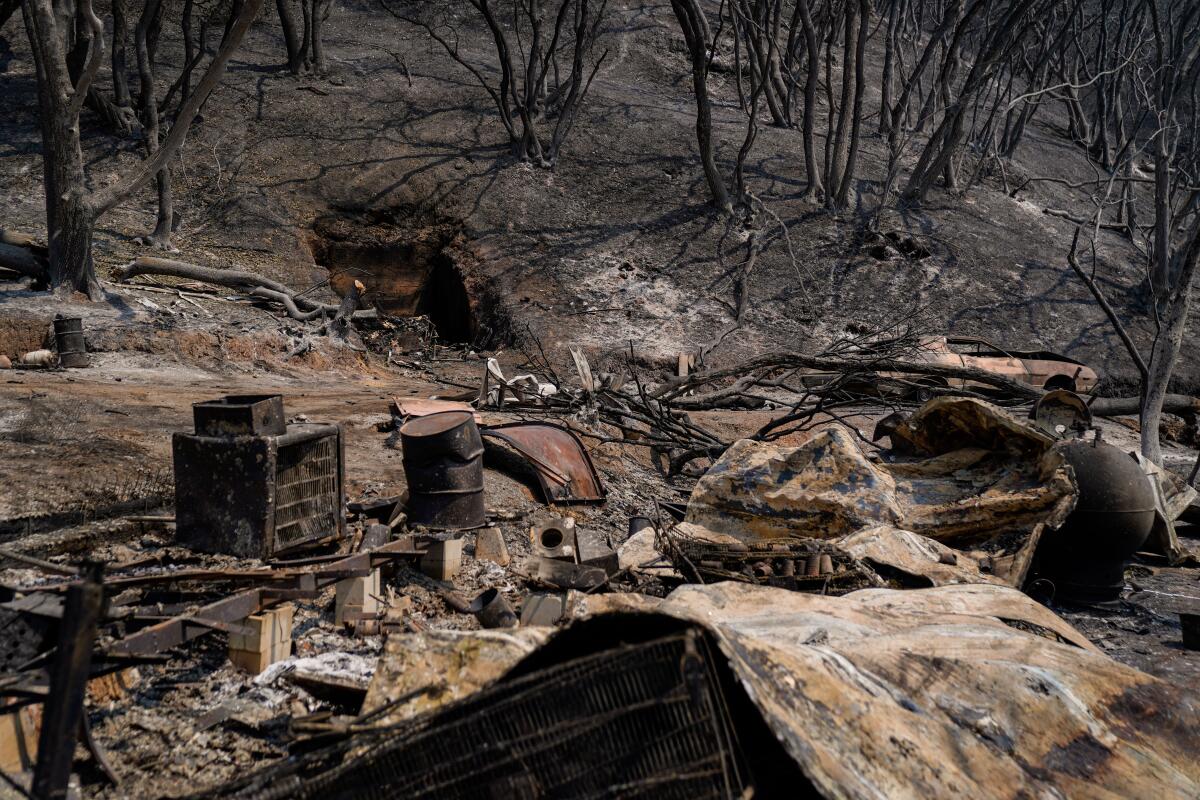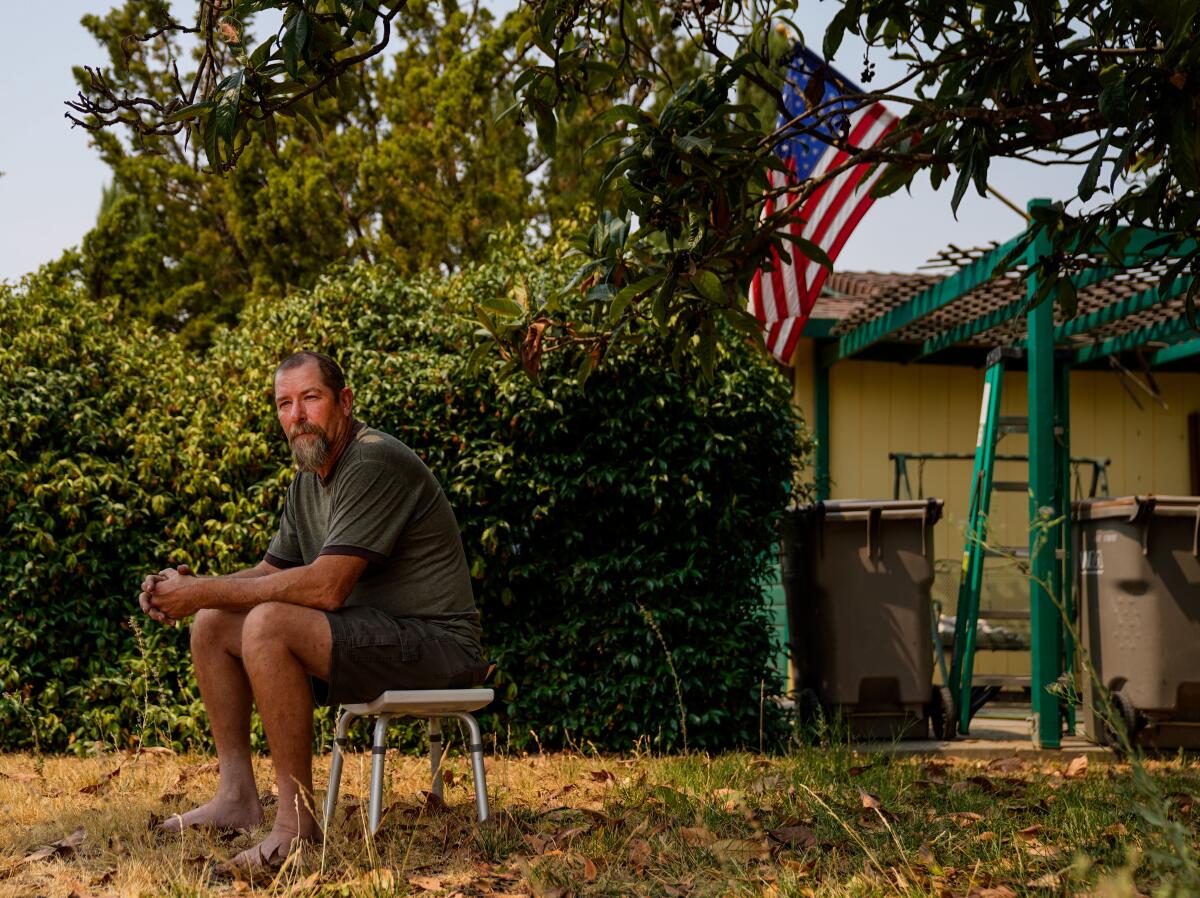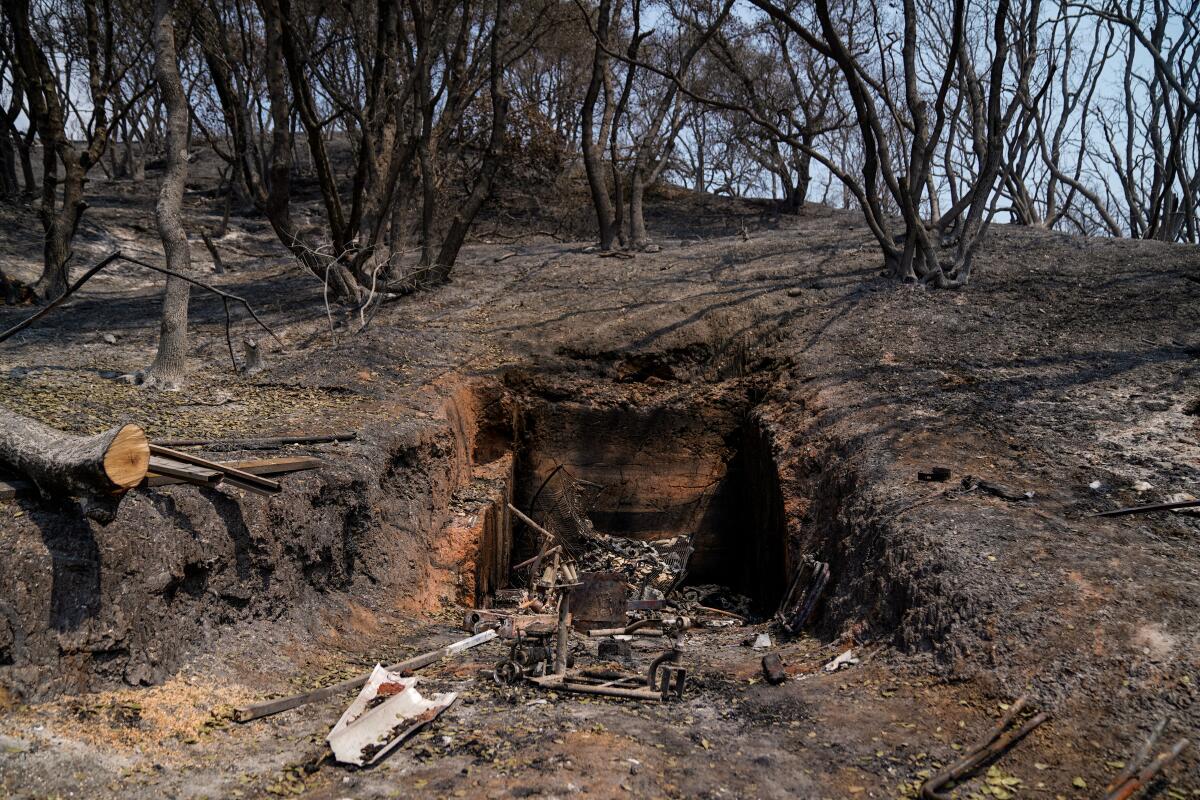They were prepped for flames, but the fire came too fast. They couldn’t outrun it

- Share via
LAKE BERRYESSA, Calif. — A week ago, Mary Hintemeyer stood in the oak grove that surrounded her Northern California home and looked out at where a fire was burning a few ridges away, unsure of its threat.
Normally, there is no cellphone signal in these parched hills that form the basin for Lake Berryessa, a reservoir that runs 15 miles across Napa County’s Vaca Mountains. But that evening, she was able to reach her oldest child, Robert McNeal, who lives 13 miles away in the closest town, Winters. He told her to get out.
As they spoke, she turned back toward the mobile home where she lived with her disabled boyfriend, Leo McDermott, and his son, Thomas. Behind it, on the ridge that loomed above her, she saw smoke — another fire coming out of nearby Wragg Canyon, which she thought had been contained.
“She said, ‘Oh my God, it’s coming over the other side toward me,’” said McNeal, remembering his last conversation with his mother. “‘I have to go.’”
In the next hours, the Markley fire and the flames from the canyon converged near her home, said McNeal, eventually becoming part of the LNU Lightning Complex, now dubbed a mega-fire and one of the largest in California history.
Tuesday, it had burned 356,000 acres and was 27% contained, according to the California Department of Forestry and Fire Protection, part of some 1.4 million acres of land consumed by flame in recent days.
Like the pandemic, wildfires are especially hard on vulnerable populations — older people, such as Hintemeyer, who was 70, and the disabled, such as Leo McDermott.
While California’s massive fires have caused a reported seven deaths so far, such fires often prey upon the most frail and least mobile, and even slightly slower-moving blazes can end in tragedy for households in the state’s high-hazard fire zones. As far back as 2008 when fires ravaged San Diego County, the state has struggled to inform and protect its most susceptible residents, some of whom lack easy access to cellphone service or the internet.
“The whole fact that we don’t have the resources, that is heartbreaking,” said Hintemeyer’s youngest daughter, Rachel Gardner, a housing specialist for the state who worked with Camp fire victims for seven months. “Especially knowing how California is, knowing we are prone to this.”
Hintemeyer was “definitely a city girl” and new to country life, said Gardner. At 17, she moved from Baltimore to Southern California, pregnant with her first son. Within five years, she had two more girls, and soon after, in the 1970s, she found herself as a single mother living in Vallejo.

Sometimes, said McNeal, money was so tight that she would work gigs such as cleaning houses on the side, though her main job then was handling the complaint desk at the Vallejo Times-Herald newspaper, fielding calls from unhappy subscribers.
But she also had a wilder side — she was a belly dancer in her off hours, making her own costumes and performing with snakes and swords. Once, she danced in a local parade with McNeal carrying the sign for her troupe.
When McNeal was older, his mother’s adventurous streak led them both to work security at concert-promoter Bill Graham Presents events, including shows for bands such as Pearl Jam and Too $hort. When her granddaughter Micheala Sanchez was about 4, she dubbed Hintemeyer the “pink grandma” because Hintemeyer dyed her hair bright red. It was a nickname that stuck through nearly two dozen grandchildren, and on to a third generation, though she eventually returned to a blond shade.
While celebrating the 21st birthday of Gardner’s daughter, Crystal, at one of the few bars in Winters, Hintemeyer met McDermott. Crystal and Mary had gone out front to smoke cigarettes, where McDermott was sitting on the tailgate of a truck.
Northern California wildfires rage through the region with possible more on the way
A well-known character in the small community, he was a “bad boy” type who rode Harley-Davidsons and had lived off the land since 1978, when he bought 43 acres, said Gardner. It was a thickly forested spot with a dirt drive as steep as a ski slope, and McDermott refused to build a house there because doing so would have increased his property taxes. He considered it a government overreach that he wouldn’t pay, though he’d made a fair sum of money off an invention that allowed him to fix the crankshaft of an engine without removing it from the vehicle, a sought-after service for farm equipment and race cars, said McNeal.
Hintemeyer and McDermott were inseparable from the day they met, said her children. Then in his 60s, McDermott walked with a cane and had left much of his wilder ways behind. Hintemeyer soon moved up to his mountain hideaway, taking pleasure in regaling her kids with her rugged achievements, like a thriving garden full of tomatoes and strawberries. At Christmas, McDermott would dress up as Santa for the kids.
But McDermott was soon diagnosed with an autoimmune disease that turned his muscles to jelly. First, he lost the use of his legs and needed a wheelchair. Then he lost function in the lower half of his body, relying on Hintemeyer for the daily tasks of life. Recently, his hands began to weaken, so that he could barely hold a fork.
But he was a “rebel” and refused to move into town, though the burden of caring for him was increasingly difficult for Hintemeyer, said McNeal.
McNeal said his mother, a religious woman, began to pray for help. She believed Tom, McDermott’s son, was the answer to that plea. Tom had disappeared after crashing his father’s car when he was 16, almost 30 years earlier. About two years ago, he walked back onto his father’s property, said McNeal.
Though Tom barely spoke those first years, McNeal said he told him that he’d been in a car accident. When he woke in the hospital, he could remember little except his father’s address. With an injured wrist, so broken that it eventually healed into a hooked shape, he fled from medical care and made his way home, where he became the third in a trio that rarely left the property because of McDermott’s health.
What happened in the final hours before fire killed Hintemeyer and the McDermotts is a painful conjecture for McNeal and his family.
Some things they know for certain. Earlier in the afternoon, Hintemeyer had tried to drive into town for supplies. But evacuation orders were already in place and a sheriff’s deputy told her if she went through his barricade, she couldn’t return. Hintemeyer turned back.
“The bottom line is she loved them,” said Gardner. “If that barrier wasn’t up and she left, she wouldn’t have been able to live with it.”
McNeal also knows that they packed up their van to leave, including presents for a grandson whose birthday was coming. But after his mother disconnected their call, something prevented them from going. McNeal believes the fire moved too fast.
Instead, the three may have tried to reach a fire bunker McDermott had built into the side of the mountain — an 8-foot box with a reinforced fire door that had been recently replaced and insulation around its sides.

On Tuesday, all that remained of that bunker were smooth-hewn dirt walls, with the metal skeleton of McDermott’s wheelchair on its side near the entrance. In the space that was meant to provide a safe haven, a metal rack had wilted in the heat, spilling dozens of cans of blackened food and melted green bottles into still-smoldering ash. Above it on the hillside, the oaks stood sentinel, their canopies burned clean.
It is not known if they made it to the shelter.
For Gardner, who heard so many similar stories during her time working with Camp fire survivors, there is frustration along with sorrow. She and her brother believe the fire bunker and a water truck hooked up to a well gave her family a false sense of safety. She wants others to know that you can’t predict a fire, and the consequences of being wrong are not worth the risk.
“We will never have all the answers. I am certain Leo was sitting there telling my mom and his son he was sorry. I am sure my mom was praying,” said Gardner. “I can’t stress it enough, when you are told to evacuate, evacuate.”
More to Read
Sign up for Essential California
The most important California stories and recommendations in your inbox every morning.
You may occasionally receive promotional content from the Los Angeles Times.












